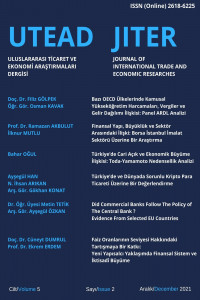TÜRKİYE’DE SAVUNMA, SAĞLIK VE EĞİTİM HARCAMALARININ EKONOMİK BÜYÜME ÜZERİNE ETKİLERİ
Kamu harcamaları ile ekonomik büyüme arasındaki tartışmalı ilişki özellikle ABD’de 1929 yılında başlayan büyük buhrandan sonra çok merak edilen bir konu haline gelmiştir. Ülkelerin kamu harcamalarındaki bir artışın diğer ekonomik değişkenlerin yanı sıra o ülkelerin ekonomik büyüme performansı üzerinde de önemli etkilere sahip olması beklenmektedir. Bu amaçla çalışmada Türkiye ekonomisine ilişkin savunma, sağlık ve eğitim harcamaları ile ekonomik büyüme arasındaki ilişkinin tespit edilmesi için 1981-2016 dönemini kapsayan yıllık verilerden oluşan bir veri seti kullanılmıştır. Serilerin Fourier birim kök test sonuçları ekonomik büyüme ve eğitim harcaması serilerinin seviyede durağan, savunma ve sağlık harcaması serilerinin ise fark durağan olduğunu göstermiştir. Uzun dönem ilişkileri tespit etmek amacıyla yapılan ARDL sınır testi tahmin sonuçları savunma, sağlık ve eğitim harcamaları ile ekonomik büyüme arasında pozitif yönde ilişki olduğunu ve sırasıyla 0.33, 0.17 ve 1.33 değerlerini aldığını ortaya koymaktadır. Diğer bir ifadeyle ele alınan kamu harcama çeşitlerinden ekonomik büyümeyi en fazla eğitim harcamalarının daha sonra ise sırasıyla savunma ve sağlık harcamalarının etkilediği tespit edilmiştir.
Anahtar Kelimeler:
Kamu harcamaları, ekonomik büyüme, ARDL
THE IMPACTS OF DEFENSE, HEALTH AND EDUCATION EXPENDITURES ON ECONOMIC GROWTH IN TURKEY
The controversial relationship between public expenditures and economic growth has become one of the famous matters of interest, especially following the Great Depression that began in the US in 1929. As well as other economic variables, an increase in the public expenditure of the countries is expected to have significant impacts on those countries’ economic growth performance. Therefore, an annual data set covering the period between the years 1981-2016 is used to determine the relationship of defense, health and education expenditures in the Turkish economy with economic growth. The Fourier unit root test results of the series indicate that economic growth and education expenditure series are stationary in the level, and defense and health expenditure series are stationary in the first difference. The estimation results of ARDL bound test, which is conducted to detect the long-term relationships, indicate that defense, health, and education expenditures are positively related to economic growth at the values of 0.33, 0.17 and 1.33, respectively. In other words, it is determined that economic growth be mostly affected by education expenditures followed by defense and health expenditures, respectively.
Keywords:
Public expenditure, Economic growth, ARDL,
___
- Abu-Bader, S., & Abu-Qarn, A. S. (2003). Government expenditures, military spending and economic growth: causality evidence from Egypt, Israel, and Syria. Journal of Policy Modeling, 25(6), 567-583.
- Aksoğan, G., & Elveren, A. Y. (2012). Türkiye'de Savunma, Sağlık ve Eğitim Harcamaları ve Gelir Eşitsizliği (1970-2008): Ekonometrik Bir İnceleme. Sosyoekonomi, 17(17).
- Alam, I., & Quazi, R. (2003). Determinants of capital flight: An econometric case study of Bangladesh. International Review of Applied Economics, 17(1), 85-103.
- Aytaç, D., & Güran, M. C. (2010). Kamu Harcamalarinin Bilesimi Ekonomik Büyümeyi Etkiler Mi? Türkiye Ekonomisi Icin Bir Analiz. Sosyoekonomi, (2), 129.
- Bakırtaş, İ. (2015). Kamu Harcamalarının Temel Makroekonomik Göstergelerle İlişkisi Ve Nedenselliği (1983-2000 Türkiye Örneği). Dumlupınar Üniversitesi Sosyal Bilimler Dergisi, 9(9).
- Barro, R. J. (1988). Goverment Spending in a Simple Model of Endogenous Growth’’, NBER Working Paper, No: 2588.
- Gül, E., & Yavuz, H. (2010). AB’nin Yeni Üyeleri ile Türkiye’de Kamu Harcamaları ve Ekonomik Büyüme İlişkisi: 1996-2008 Dönemi. Maliye Dergisi, 158, 164-178.
- Kanca, O. C. (2011). Kamu harcamalarının ekonomik büyüme üzerine etkisi 1980-2008 (ampirik bir çalışma). Atatürk Üniversitesi İktisadi ve İdari Bilimler Dergisi, 25(1).
- Landau, D. (1983). Government expenditure and economic growth: a cross-country study. Southern Economic Journal, 783-792.
- Narayan, P. K. (2005). The saving and investment nexus for China: evidence from cointegration tests. Applied economics, 37(17), 1979-1990.
- Pamuk, M. & Bektaş, H. (2014). Türkiye’de Eğitim Harcamaları ve Ekonomik Büyüme Arasındaki İlişki: ARDL Sınır Testi Yaklaşımı. Siyaset, Ekonomi ve Yönetim Araştırmaları Dergisi, 2(2).
- Pehlivan, O. (2008). Kamu Maliyesi, Derya Kitabevi.
- Pesaran, M. H., Shin, Y., & Smith, R. J. (2001). Bounds testing approaches to the analysis of level relationships. Journal of applied econometrics, 16(3), 289-326.
- Ram, R. (1986). Government size and economic growth: A new framework and some evidence from cross-section and time-series data. The American Economic Review, 76(1), 191-203.
- Romer, P. M. (1986). Increasing returns and long-run growth. Journal of political economy, 94(5), 1002-1037.
- Shahbaz, M., & Lean, H. H. (2012). Does financial development increase energy consumption? The role of industrialization and urbanization in Tunisia. Energy policy, 40, 473-479.
- Tang, T. C. (2010). Wagner's Law Versus Keynesian Hypothesis in Malaysia: An Impressionistic View. International Journal of Business and Society, 11(2), 87.
- Topal, M. H., Ünver, M., & Türedi, S. (2017). The Impact of Government Quality and Public Sector Size on Economic Growth in Turkic Republics: An Empirical Analysis. Eurasian Business & Economic Journal, 8, 113-133.
- Uzay, N. (2002). Kamu büyüklüğü ve ekonomik büyüme üzerindeki etkileri: Türkiye örneği (1970-1999). Erciyes Üniversitesi, İİBF. Dergisi, (19), 151-172.
- Yaraşır Tülümce, S.& Zeren, F. (2017). Türkiye’de kamu harcamaları ve ekonomik büyüme arasındaki ilişkinin asimetrik nedensellik testi ile analizi. Uluslararası Yönetim İktisat ve İşletme Dergisi, 13(2), 299-310.
- ISSN: 2564-7318
- Başlangıç: 2017
- Yayıncı: Mehmet ŞENTÜRK
Sayıdaki Diğer Makaleler
BATI AKDENİZ BÖLGESİ DIŞ TİCARETİNDE MEVSİMSEL FARKLILAŞMA: FRİEDMAN ANALİZİ
EKONOMİK BÜYÜME VE ENERJİ TÜKETİMİNİN ÇEVRE KİRLİLİĞİNE ETKİSİ: PANEL VERİ ANALİZİ
Gökçen SAYAR ÖZKAN, Muhyettin ERDEMLİ
YENİLENEBİLİR ENERJİ VE EKONOMİK BÜYÜME: AVRUPA BİRLİĞİ VE TÜRKİYE ÜZERİNE BİR ARAŞTIRMA
KİLİKYA KORİDORUNUN TURİZM ANALİZİ
Celile ÖZÇİÇEK DÖLEKOĞLU, Selim GÜNDÜZ, Alper BOZKURT
EXİMBANK "TEMİNAT MEKTUBU" TOPLAMA BANKASI MI?
Özgür KIZILDEMİR, Mehmet SARIIŞIK
ENFLASYON VE İŞSİZLİK ARASINDAKİ İLİŞKİ: TÜRKİYE İÇİN ARDL SINIR TESTİ YAKLAŞIMI
LOJİSTİK PERFORMANS VE İLİŞKİ KALİTESİ ÜZERİNE ALANYAZIN İNCELEMESİ
Hanifi Murat MUTLU, Semir ÖLMEZ
TÜRKİYE’DE SAVUNMA, SAĞLIK VE EĞİTİM HARCAMALARININ EKONOMİK BÜYÜME ÜZERİNE ETKİLERİ
